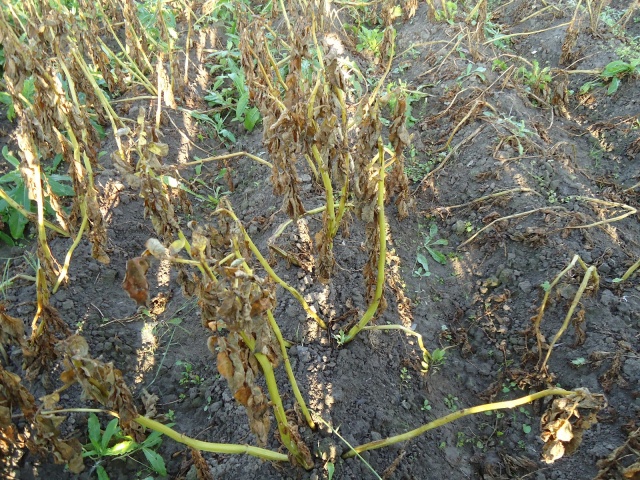 Getting a good potato crop depends on the condition of the soil, planting material, weather conditions. Sometimes it’s all there, but the crop is bad or quickly deteriorates.
Getting a good potato crop depends on the condition of the soil, planting material, weather conditions. Sometimes it’s all there, but the crop is bad or quickly deteriorates.
Healthy, green and juicy tops are an indicator of the health of tubers and a guarantee of the preservation of the crop.
Content
Description of the causes of blackening of tops of potatoes
Potato tops dry up at the end of the growing season, but sometimes long before this period it begins to wither, blacken, and the leaves dry. Such a pattern can be observed during flowering, before the appearance of flowers and during the period of active growth of potatoes.
The cause may be a disease or pests.
The following factors may cause the disease.:
- wrong choice of planting material: non-zoned varieties lose their resistance to diseases (hybrid varieties are resistant to diseases);
- crop rotation disturbance: pathogens are often stored in the soil and, when the crop rotation is incorrect, they infect plants at the beginning of growth or during the ripening period;
- the choice of a place for planting (near groundwater, clay soil);
- non-observance of the rules for caring for the plant: excessive wetting causes late blight, too high a temperature - diseases caused by a fungus.
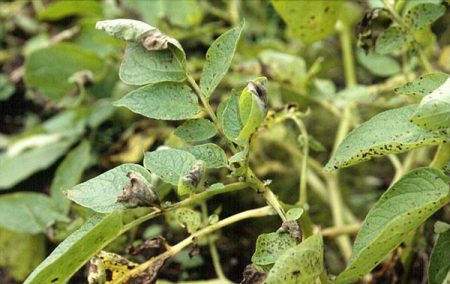
Potato Diseases are Different pathogens causing the disease:
- Bacteria: transmitted through infected planting material and soil, where they remain for a long time, resistant to low temperatures. Diseases: rot, black leg.
- Viruses cause a change in the structure of the whole aerial part and the plant is already unable to form tubers. Diseases: various types of mosaics.
- Fungus tubers and the whole aerial part are affected, the infected plant becomes unstable to other diseases. Diseases: fusarium, alternariosis, rhizoctoniosis, late blight, rhizoctoniosis.
What diseases cause foliage to turn black?
Consider the most common potato diseases, which are characterized by blackening of tops.
Phytophthora
Phytophthora, late blight, brown rot - the name of the disease of potato and nightshade, the causative agent of the fungus Phitophtora infestans.
Most often, the disease appears after mid-July, when temperature fluctuations occur, an excess of moisture is noticed.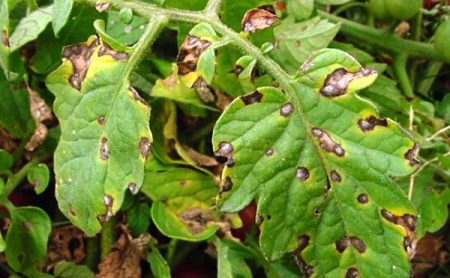
Mushroom Features:
- fast reproduction;
- distributed by zoospores in the soil, on tubers, in places of storage of the crop;
- when watering, it enters the soil from diseased plants;
- moisture and heat - conditions for the rapid spread of the fungus.
Signs of the disease:
- brown spots with a whitish bloom on the lower leaves (fungal spores);
- stripes of dark brown color on the stems;
- dark spots on tubers.
In the future, if no measures are taken, signs appear on all leaves, all stems are affected, tubers begin to rot.
Preventive actions:
- the introduction of antifungal drugs into the soil;
- mulching the soil between the bushes;
- disinfection of soil with siderates (legumes, mustard, rye);
- selection of material for planting (choose varieties resistant to fungal diseases);
- observe crop rotation;
- planting away from nightshade (protection against fungal transmission);
- not to thicken the planting (at small distances between the bushes, airing is poor);
- carry out hilling (a layer of the earth prevents the spread of fungus);
- inspection of plants and removal of infected;
- treatment with drugs from late blight.
Chemical treatment scares many people because of the ability of chemicals to accumulate in soil and tubers, so home treatment methods are popular. They must be used at the first sign of illness.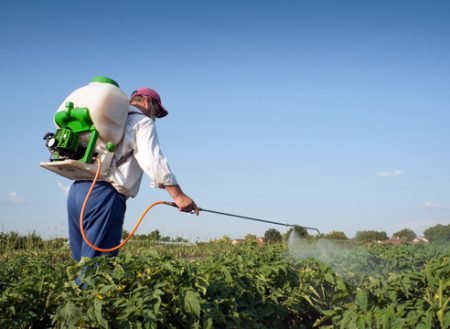
Recipes from late blight:
- Garlic infusion: day, insist in a bucket of water 100 g of garlic (finely chopped), spray on tops every seven days for a month. Use infusion fresh.
- Kefir infusion: mix sour kefir (1 liter) with a bucket of water, stand for 2-3 hours. Every seven days, before harvesting, spray the bushes with infusion.
- A solution of potassium permanganate (potassium permanganate), boric acid, copper sulfate: stir each agent (1 tsp) in boiling water (1 liter), cool and combine the resulting three liters with 7 liters of water, stir. To carry out processing in July and in August (between treatments a gap of several weeks).
Sometimes home remedies do not help, then you have to use chemicals to save the plantings.
Chemical processing steps:
- tubers before planting (Fitosporin - M);
- tops 25-30cm high (vitriol, Bordeaux liquid, copper sulfate);
- before flowering (wet weather - Epin, Oksigumat, Exiol; dry weather - Silkom, Krezatsin);
- processing 1-2 weeks after the previous one (Efal, Ditan-M45);
- after 14 days, treat with potent drugs for infection of large areas (Oksikhom, Ridomil);
- after flowering (Bravo drug);
- tuber formation and ripening (Alufit preparation).
Pre-sowing soil treatment and selection of seed to prevent the occurrence of the disease are more preferable measures than the treatment of a diseased plant.
Alternariosis
Alternariosis is a disease of potato and nightshade crops caused by imperfect fungi.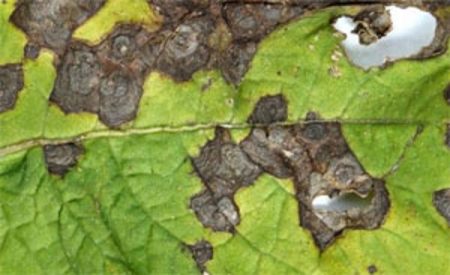
Features of Alternaria:
- appears before flowering begins; the entire period of growth and maturation develops;
- varieties with medium ripening periods are more often affected;
- the aerial part is affected (tubers become less infected);
- fungal spores are carried with raindrops, wind, insects;
- the mushroom hibernates on the remains of plants.
Alternariosis develops under the conditions of:
- little moisture;
- dry weather with high temperatures;
- parasitic infection of the leaves;
- nitrogen and potassium starvation;
- a large amount of phosphorus;
- tuberous viral infection.
Signs of Alternariosis:
- Dry roundish-angular spots of brown color appear up to 3.5 cm in diameter on the lower leaves (2-3 weeks before flowering). The spots are located in the center of the sheet, rings are visible on them.
- The sheet becomes dry, brittle.
- There is a raid with spores in 2-3 weeks.
- Stem infection occurs in the same way.
- On diseased tubers there are depressed spots with spores.
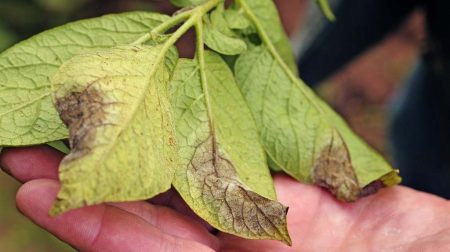
The fight against alternariosis:
- spraying with drugs Thanos, Utan, Mancozeb and others according to the instructions for the drug;
- start treatment when signs of the disease appear;
- Only 4 treatments per growing period.
The emergence and spread alternariosis depends on preventive measures:
- Removal from the site and destruction of diseased plants.
- Plowing the soil helps the rapid decomposition of plant debris on which spores live.
- Isolate planting potatoes and nightshade.
- To grow potatoes in one place for no more than three years.
- The balanced composition of fertilizers.
- Choose varieties resistant to alternariosis.
- Clean only ripened tubers without damaging them.
- Remove infected and damaged tubers before storage.
- Use Integral, Bactofit, Planriz preparations before planting.
Fusarium
Fusarium (dry rot, fusarium wilt) - a plant disease caused by fungi of the genus Fusarium.
Most often, potato infection occurs during the formation and development of tubers. From infection to the onset of symptoms of the disease takes about a month.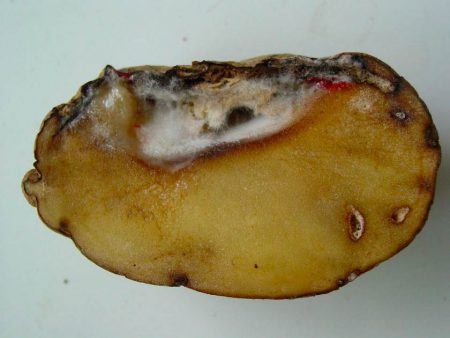
Signs of Fusarium:
- the plant lacks moisture (absorption function is violated) - the upper leaves become colorless, curl along the leaf;
- yellowing and falling of leaves;
- the upper part of the stem becomes brown, rots (a plaque in the form of a web becomes noticeable) and dries;
- the tubers of the infected plant rot during storage (1-2 months after harvesting), dry.
Features of Fusarium:
- fungi - pathogens live on plant debris, in soil, on seed material;
- fungi penetrate the plant through the root system, through cracks, mechanical damage and damage left by pests;
- there is a violation of the plant's supply of nutrients (clogged vessels).
Fusarium Prevention:
- Removing weed from the site.
- Pest control.
- Mowing tops before harvesting.
- Prevent damage to tubers during harvesting.
- Inspection and drying of tubers (infected remove).
- Airing, drying and disinfection of the storage room (solution of 2 kg of bleach and 10 liters of water).
- Compliance with crop rotation.
- Preparation of material for planting: proper germination, disinfection with a solution of copper sulfate (2 g) and potassium permanganate (15 g) in 10 liters of water.
- Planting potatoes at 8-10 °.
- Fertilizing the soil with nutritious mixtures.
- Hilling.
- Processing 1% Bordeaux liquid before flowering and during flowering.
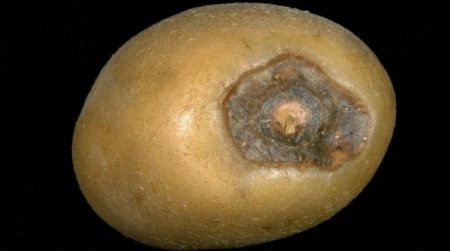
Rhizoctonia
Rhizoctonia - fungal disease of plants, pathogen fungus Rhizoctonia solani Kuehn.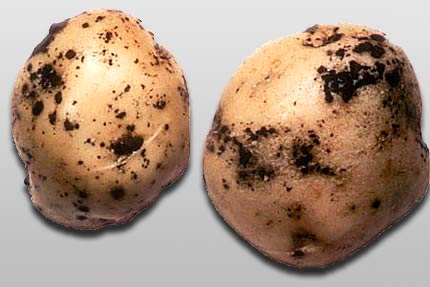
Features of rhizoctoniosis:
- fungal spores live in the earth for 3-4 years, survive at very low temperatures;
- parasitizes on nightshade, cruciferous, pumpkin and many other plants;
- transmitted with soil, rainwater;
- maximally reproduces at 15-17 °;
- infection is possible at all stages of growth;
- prefers poorly fertilized, moist and clay soils.
Signs of rhizoctoniosis:
1. The disease can be detected by tubercles (sclerotia), similar to dried mud, on tubers. Their merger forms a larger “dirty” spot. Sclerotia is a form of fungal existence in the sleep phase.
2. At temperatures above 5 ° and high humidity, sclerotia grows in the mycelium, which spreads throughout the tuber, processes during germination, along the roots. The infected tuber can rot without germination.
3. If the infected plant sprouts, it will be different from healthy: low growth, dark spots of brown color (black rot) are visible on the tuberous processes and the neck of the root, the stem is thickened in the lower part, the leaves at the top change color to lilac and twist. The diseased bush wilts when it is dry and warm, recovering at night. In drought, infected bushes die first.
4. The mycelium on the tuber grows, this leads to the formation of ulcers filled with rot, in the future the tuber turns into dust.
5. The stem below is covered with a white film in damp weather with average temperatures - this is evidence of infection of the tubers. The spore of the film contains spores of the fungus. This period is called the breeding phase.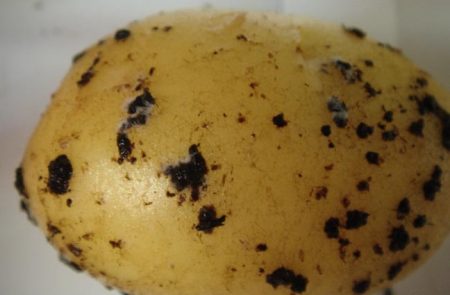
Prevention of rhizoctoniosis:
- complete replacement of seed material;
- for planting, select varieties resistant to rhizoctonia;
- crop rotation (on the same plot, plant potatoes every 3-4 years);
- use green manure on the site;
- previous plantings should not include plants prone to infection with rhizoctonia;
- organic fertilizer (120-300 kg per 10 m²);
- make ash (in the holes);
- high-quality germination in a bright room (15-30 days before planting);
- processing potatoes before planting fungicides;
- to land at temperatures above 8 °;
- the holes are not very deep (loam - 6-8cm, sandy loam - 8-11cm, peat - 12-14cm);
- Harvest a site with heavy soils on the fifth or sixth day after planting;
- timely harvesting (mid-September);
- Remove the infected tops from the site and do not use them anywhere.
Preventive measures will significantly reduce the possibility of fungal infection of vegetation in the garden, the crop and ensure its safety.
Blackleg
Blackleg - A disease caused by the bacteria Erwinia carotovora (its three varieties).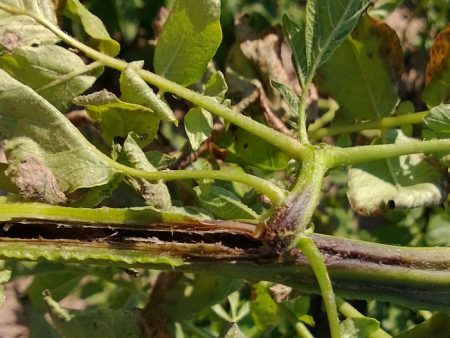
Features of the bacteria:
- unite in colonies;
- breed on all nightshade and cruciferous;
- winter only on the remains of plants;
- multiply in a humid environment and a temperature of more than 2 °;
- spread at 2-25 °.
Signs of a black leg:
- the appearance of brown spots on the stem;
- curling and drying leaves;
- shoots in the lower part soften, green mucus may appear;
- the formation of tubers does not occur under diseased bushes;
- the appearance of small brown spots on the tubers and their further growth, rotting of the tuber (pus follows, infecting everything around);
- the pathogen can be transmitted by insects (Colorado potato beetle).
Prevention of the black leg:
- Remove diseased plants and tubers from the site.
- The introduction of ammonium sulfate into the soil.
- Inspection and removal of diseased potatoes before storing.
- Drying tubers.
- Airing, drying and disinfection of the storage room.
- Covering potatoes with straw or a layer of beets during storage (beets absorb moisture).
- Sowing green manure - rye, oats, and legumes (except white mustard) disinfect the soil.
- Do not plant potatoes after infected cabbage and other cruciferous plants.
- Processing the crop with the drug "Maxim".
- Inspect the seeds for planting, remove the infected ones and treat them in a solution of formalin, potassium permanganate or spray a solution of copper sulfate.
- On the site, the place where the diseased plant grew should be treated with Bordeaux liquid or with a mixture of ash (1 liter) and copper sulfate (1 tbsp).
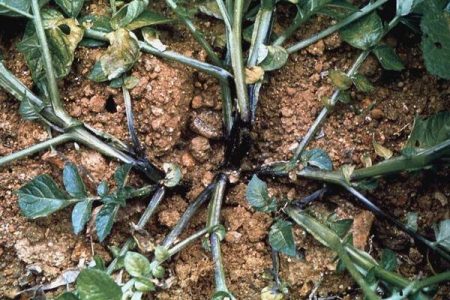
Preventive measures are available and possible for use in any household.
How to keep the tops green
Keeping the tops healthy, fresh green, requires compliance with certain rules:
- varieties must be zoned and resistant to disease;
- nutrient soil at the landing site (not heavy);
- plowing;
- adding lime to acidic soils;
- the use of siderates;
- balanced fertilizer composition (taking into account soil characteristics);
- presowing treatment of tubers;
- inspection of the crop before harvesting for storage;
- planting crops susceptible to one disease separately;
- removal of diseased plants.
Compliance with these rules will allow you to see the site with green potato crops, with healthy plants.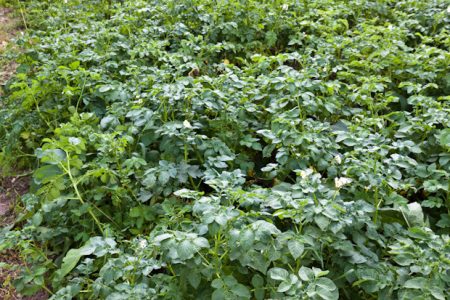
Blackened tops of potatoes - what to do?
Prevention of blackening of tops of potatoes, carried out in a timely manner, gives good results: the plant is not more or sick in mild form, gives a decent harvest.
Prevention of blackening and wilting of tops
- buy material for planting in special stores or from trusted sellers;
- correctly determine the dose of fertilizer;
- interviewing neighbors for potato diseases in their area;
- weed removal;
- mowing tops 2 weeks before digging potatoes;
- prevent contact of infected tops with healthy tops;
- do not cover the tops with dug potatoes (pathogens can get from the tops);
- dig out early varieties as they mature.
If, however, the infection of the plant has occurred, you must first determine the type of infection in order to properly prescribe the "treatment" hold events:
- process the tops with signs of the disease with a Bordeaux mixture;
- remove blackened parts;
- with the further spread of the disease, remove the entire bush;
- if the tubers are already ripe, cut the diseased tops, and dig up the tubers, inspect them;
- remove diseased bushes from the site, trying to avoid contact with healthy plants.
Reviews
Ivan
I did not have late blight in my garden until last year. The harvest was good, but a fifth died due to late blight, threw it away. In the spring before planting, I decided to process the tubers with vitriol, and in the summer I processed the potatoes three times with Infinito. And all was well!
Zinaida (Moscow region)
Potatoes and tomatoes in the garden were never ill with late blight, and two years ago the leaves of the potato blackened, then the whole bush turned black. Sprayed with a drug with copper, boric acid. The tops did not blacken anymore, but the potato did not suit me: small, some kind of crooked whole. In the spring I changed varieties, I was afraid to plant the former, and applied fertilizers to the ground - all that I collected during the winter (ash, peel of bananas, oranges and tangerines, egg shells). In the summer, I treated it just in case with a Bordeaux mixture and infusion with kefir (those who tried it advised). The potato was not sick, it grew healthy, and the harvest was very pleased, despite the rather cool and rainy summers.




 Description and description of varieties in Belarus with a photo
Description and description of varieties in Belarus with a photo Do I need to pick flowers from potatoes: why do they do it
Do I need to pick flowers from potatoes: why do they do it When to dig potatoes: timing and availability of new potatoes
When to dig potatoes: timing and availability of new potatoes How to grow a good potato crop: various methods and methods, planting and care
How to grow a good potato crop: various methods and methods, planting and care